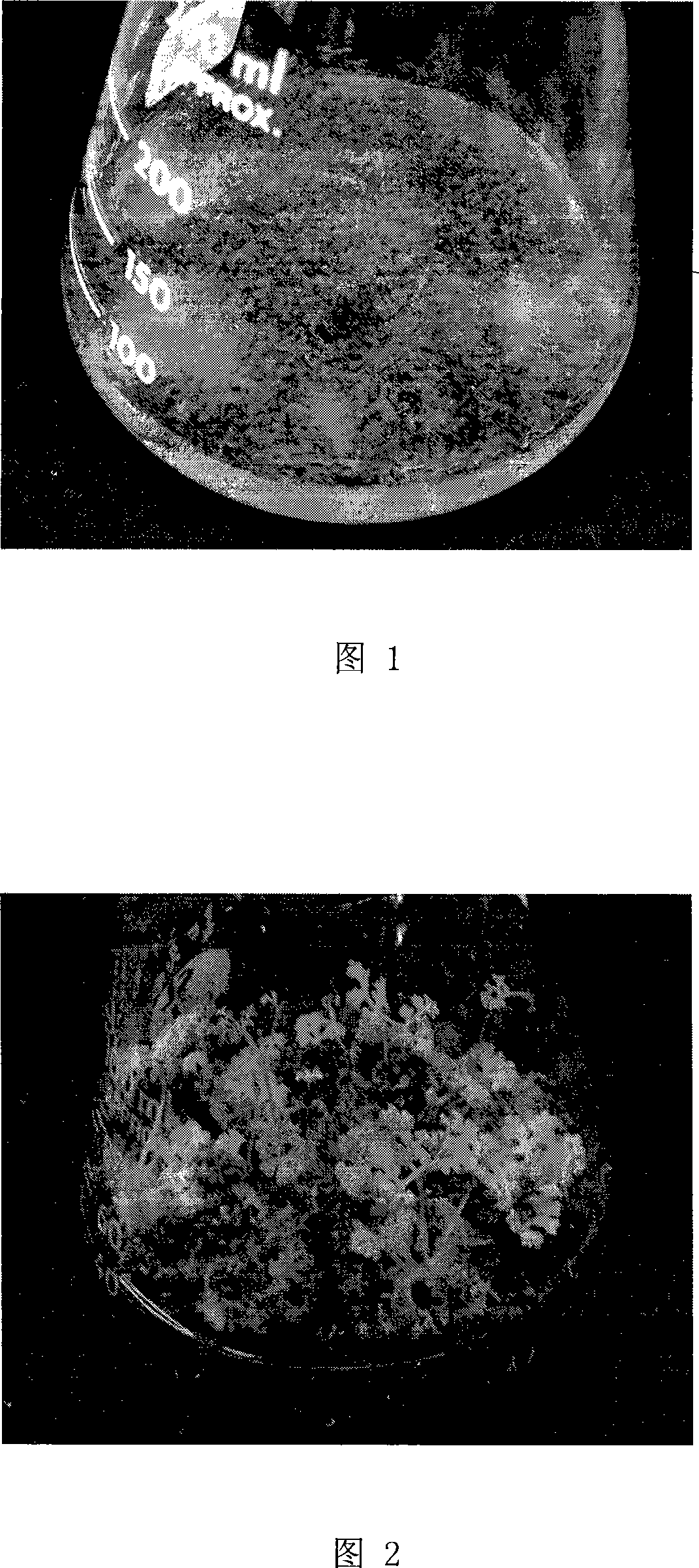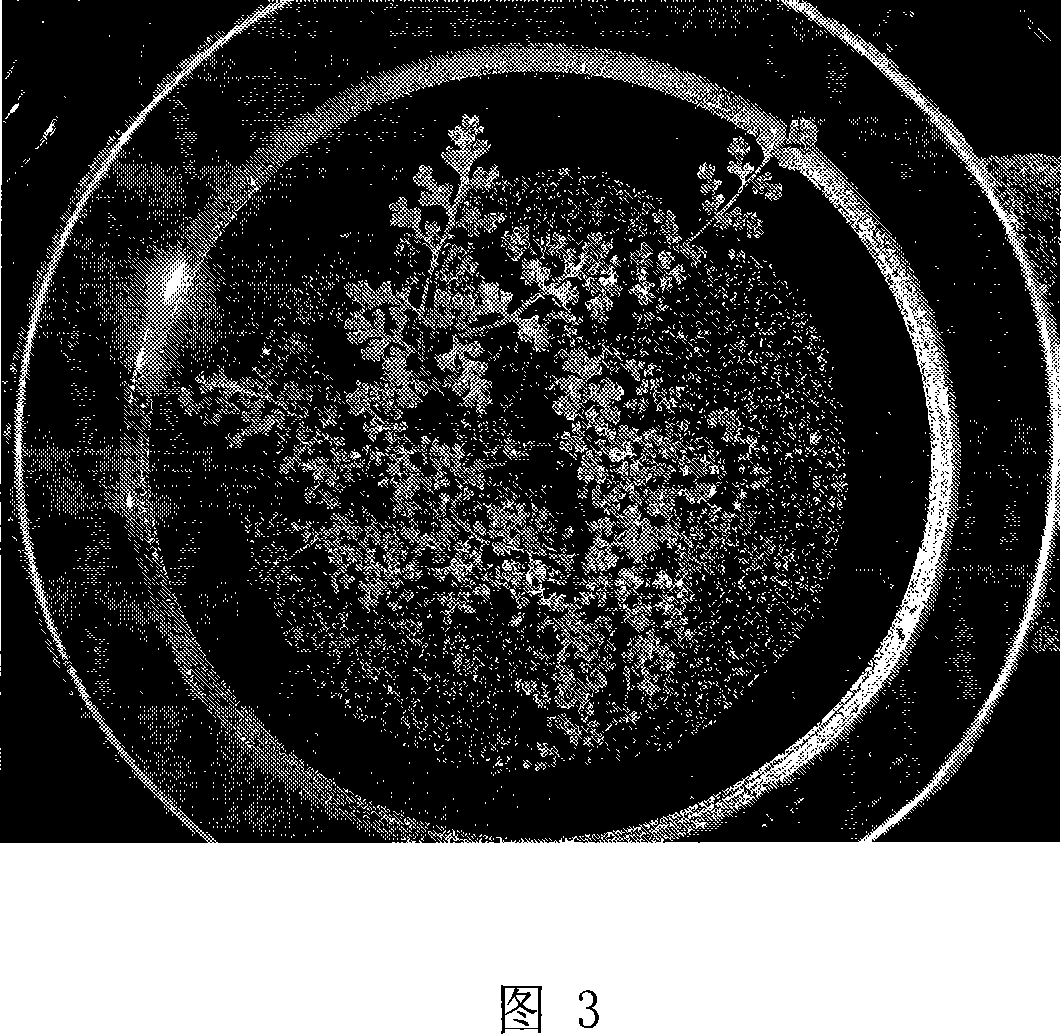Breeding method for alsophila spinulosa
A technology of Cyaphila spinulosa and Cyaphila spinulosa spores, which is applied in the field of plant propagation, can solve problems such as lack of detailed reports, lagging technology of artificial propagation and cultivation of Cyaphilopinaceae plants, and destruction of wild Cyaphila spinulosa resources, so as to achieve short cultivation period and reduce wild resources and environment Destructive, low-cost effects
- Summary
- Abstract
- Description
- Claims
- Application Information
AI Technical Summary
Benefits of technology
Problems solved by technology
Method used
Image
Examples
Embodiment 1
[0024] Embodiment 1, alsophila spinulosa (Alsophila spinulosa (Wall.ex Hook.) Tryon) propagation
[0025] 1. Preparation of 1 / 2MS medium
[0026] The composition of 1 / 2 MS medium is the same as MS medium, in which the concentration of macroelements and trace elements is 1 / 2 of MS medium, the concentration of iron salt and organic components is the same as MS medium, agar 7g / L , pH is 5.8. After boiling and dissolving, divide into 100ml Erlenmeyer flasks, and then sterilize by high pressure steam at 121°C for 20min.
[0027] 2. Sterilization of spinosa spores
[0028] Take 5 mg of mature spinulosa (Alsophila spinulosa (Wall.ex Hook.) Tryon) spores and place them in a 1.5ml centrifuge tube, drop them into sterile water, oscillate fully to form a suspension, let stand for 1 hour, and then centrifuge at 4000r / min for 2 minutes. Discard the supernatant; then drop about 1.0ml of a disinfectant solution containing 0.2g / 100ml Tween-80 and 5g / 100ml NaClO into the centrifuge tube to ...
Embodiment 2
[0033]Embodiment 2, alsophila spinulosa (Alsophila spinulosa (Wall.ex Hook.) Tryon) propagation
[0034] 1. Preparation of 1 / 8MS medium
[0035] The composition of 1 / 8 MS medium is the same as MS medium, in which the concentration of macroelements and trace elements is 1 / 8 of MS medium, the concentration of iron salt and organic components is the same as MS medium, agar 6.5g / L , pH 5.5. After boiling and dissolving, divide into 100ml Erlenmeyer flasks, and then sterilize by high pressure steam at 121°C for 20min.
[0036] 2. Sterilization of spinosa spores
[0037] Take 2mg of mature spinosa spores, put them in a 1.5ml centrifuge tube, drop them into sterile water, oscillate fully to make a suspension, let stand for 1h, centrifuge at 4000r / min for 2min, discard the supernatant; then drop about 1.0ml of disinfectant solution containing 0.1g / 100ml Tween-80 and 3g / 100ml NaClO to sterilize the spores, after 4.5min, centrifuge at 4000r / min for 1min, discard the supernatant; fina...
Embodiment 3
[0042] Embodiment 3, the reproduction of Alsophila spinulosa (Wall.ex Hook.) Tryon
[0043] 1. Preparation of full MS medium
[0044] The concentrations of macroelements and trace elements and iron salts are the same as those in MS medium, the concentrations of iron salts and organic components are the same as those in MS medium, the agar is 8g / L, and the pH is 6.0. After boiling and dissolving, divide into 100ml Erlenmeyer flasks, and then sterilize by high pressure steam at 121°C for 20min.
[0045] 2. Sterilization of spinosa spores
[0046] Take 7mg of mature spinosa spores, put them into a 1.5ml centrifuge tube, drop them into sterile water, oscillate fully to make a suspension, let stand for 1h, centrifuge at 4000r / min for 2min, discard the supernatant; then drop about 1.0ml of disinfectant solution containing 0.3g / 100ml Tween-80 and 6g / 100mlNaClO to sterilize the spores, after 6min, centrifuge at 4000r / min for 1min, discard the supernatant; finally rinse with sterile ...
PUM
 Login to View More
Login to View More Abstract
Description
Claims
Application Information
 Login to View More
Login to View More - R&D
- Intellectual Property
- Life Sciences
- Materials
- Tech Scout
- Unparalleled Data Quality
- Higher Quality Content
- 60% Fewer Hallucinations
Browse by: Latest US Patents, China's latest patents, Technical Efficacy Thesaurus, Application Domain, Technology Topic, Popular Technical Reports.
© 2025 PatSnap. All rights reserved.Legal|Privacy policy|Modern Slavery Act Transparency Statement|Sitemap|About US| Contact US: help@patsnap.com


